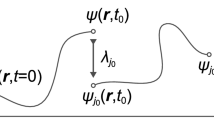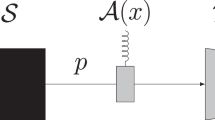Abstract
Random numbers are a valuable component in diverse applications that range from simulations1 over gambling to cryptography2,3. The quest for true randomness in these applications has engendered a large variety of different proposals for producing random numbers based on the foundational unpredictability of quantum mechanics4,5,6,7,8,9,10,11. However, most approaches do not consider that a potential adversary could have knowledge about the generated numbers, so the numbers are not verifiably random and unique12,13,14,15. Here we present a simple experimental setup based on homodyne measurements that uses the purity of a continuous-variable quantum vacuum state to generate unique random numbers. We use the intrinsic randomness in measuring the quadratures of a mode in the lowest energy vacuum state, which cannot be correlated to any other state. The simplicity of our source, combined with its verifiably unique randomness, are important attributes for achieving high-reliability, high-speed and low-cost quantum random number generators.
This is a preview of subscription content, access via your institution
Access options
Subscribe to this journal
Receive 12 print issues and online access
$209.00 per year
only $17.42 per issue
Buy this article
- Purchase on Springer Link
- Instant access to full article PDF
Prices may be subject to local taxes which are calculated during checkout



Similar content being viewed by others
References
Metropolis, N. & Ulam, S. The Monte Carlo method. J. Am. Statist. Assoc. 44, 335–341 (1949).
Schindler, W. Cryptographic Engineering Ch. 2 (Springer Science + Business Media, 2009).
Gisin, N., Ribordy, G., Tittel, W. & Zbinden, H. Quantum cryptography. Rev. Modern Phys. 74, 145–195 (2002).
Walker, J. HotBits: genuine random numbers. http://www.fourmilab.ch/hotbits/.
Jennewein, T., Achleitner, U., Weihs, G., Weinfurter, H. & Zeilinger, A. A fast and compact quantum random number generator. Rev. Sci. Instrum. 71, 1675–1680 (2000).
Stefanov, A., Gisin, N., Guinnard, O., Guinnard, L. & Zbinden, H. Optical quantum random number generator. J. Mod. Opt. 47, 595–598 (2000).
Bronner, P., Strunz, A., Silberhorn, C. & Meyn, J. P. Demonstrating quantum random with single photons. Eur. J. Phys. 30, 1189–1200 (2009).
Kwon, O., Cho, Y.-W. & Kim, Y.-H. Quantum random number generator using photon-number path entanglement. Appl. Opt. 48, 1774–1778 (2009).
Dynes, J. F., Yuan, Z. L., Sharpe, A. W. & Shields, A. J. A high speed, postprocessing free, quantum random number generator. Appl. Phys. Lett. 93, 031109 (2008).
Stipcevic, M. & Rogina, B. M. Quantum random number generator based on photonic emission in semiconductors. Rev. Sci. Instrum. 78, 045104 (2007).
Trifonov, A. & Vig, H. Quantum noise random number generator. US patent 7,284,024 (2007).
Fiorentino, M., Santori, C., Spillane, S. M., Beausoleil, R. G. & Munro, W. J. Secure self-calibrating quantum random-bit generator. Phys. Rev. A 75, 032334 (2007).
Pironio, S. et al. Random numbers certified by Bell's theorem. Nature 464, 1021–1024 (2010).
Svozil, K. Three criteria for quantum random-number generators based on beam splitters. Phys. Rev. A 79, 054306 (2009).
Sych, D. & Leuchs, G. Quantum uniqueness. Preprint at arXiv:1003.1402 (2010).
Marsaglia, G. Diehard: a battery of tests of randomness. http://www.stat.fsu.edu/pub/diehard/.
Brown, R. Dieharder. http://www.phy.duke.edu/~rgb/General/dieharder.php.
Walker, J. ENT test suite. http://www.fourmilab.ch/random/.
Rukhin, A. et al. A statistical test suite for random and pseudorandom number generators for cryptographic applications. National Institute of Standards and Technology, Special Publication 800–22 (NIST, 2001).
L'Ecuyer, P. & Simard, R. TestU01: A C library for empirical testing of random number generators. ACM Trans. Math. Softw. 33, 22 (2007).
Uchida, A. et al. Fast physical random bit generation with chaotic semiconductor lasers. Nature Photon 2, 728–732 (2008).
Agnew, G. B. Advances in Cryptology—EUROCRYPT'87, 77–81 (Springer Verlag, 1988).
Wallace, C. S. Physically random generator. Comput. Syst. Sci. Eng. 5, 82–88 (1990).
Impagliazzo, R. & Luby, M. One-way functions are essential for complexity based cryptography. In 30th FOCS, 230–235 (IEEE Computer Society, 1989).
Cachin, C. Hashing a source with an unknown probability distribution. Proceedings of the IEEE International Symposium on Information Theory (IEEE, 1998).
Schneier, B. Applied Cryptography: Protocols, Algorithms, and Source Code in C (John Wiley & Sons, 1996).
Barreto, P. S. L. M. & Rijmen, V. The whirlpool hashing function. http://www.larc.usp.br/~pbarreto/WhirlpoolPage.html (2010).
Stinson, D. R. Universal hashing and authentication codes. Designs, Codes and Cryptography 4, 369–380 (1994).
Peres, Y. Iterating von Neumann's procedure for extracting random bits. Ann. Stat. 20, 590–597 (1992).
Tomamichel, M., Schaffter, C., Smith, A. & Renner, R. Leftover hashing against quantum side information. Preprint at arXiv:1002.2436 (2010).
Acknowledgements
This work was supported by the EU project Q-ESSENCE and the Danish Research Council.
Author information
Authors and Affiliations
Contributions
U.L.A. conceived the original concept and proposed the experiment. Experimental work and some of the data analysis were carried out by C.G. together with C.W. and R.D.. W.M. conducted the theoretical investigations on the hashing and statistical tests as well as the final data analysis. D.S. contributed to theoretical investigations and proposed the idea of unique random numbers. Project planning was carried out by C.W., U.L.A., D.S., C.M. and C.G.. The paper was written by C.G., C.W., W.M., C.M., D.S., U.L.A. and G.L.. The project was initiated and supervised by U.L.A., C.M. and G.L.
Corresponding author
Ethics declarations
Competing interests
The authors declare no competing financial interests.
Rights and permissions
About this article
Cite this article
Gabriel, C., Wittmann, C., Sych, D. et al. A generator for unique quantum random numbers based on vacuum states. Nature Photon 4, 711–715 (2010). https://doi.org/10.1038/nphoton.2010.197
Received:
Accepted:
Published:
Issue Date:
DOI: https://doi.org/10.1038/nphoton.2010.197
This article is cited by
-
Recent progress in quantum photonic chips for quantum communication and internet
Light: Science & Applications (2023)
-
Provably-secure quantum randomness expansion with uncharacterised homodyne detection
Nature Communications (2023)
-
Resolution of 100 photons and quantum generation of unbiased random numbers
Nature Photonics (2023)
-
A comprehensive review of quantum random number generators: concepts, classification and the origin of randomness
Quantum Information Processing (2023)
-
Optical quantum random number generators: a comparative study
Optical and Quantum Electronics (2023)



